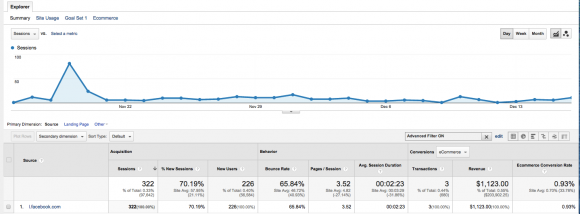Data is Powerful
As we dive into this data-driven world, it’s important to understand what challenges lie before us. No longer do we find ourselves thirsting for real-time information. Instead, we quickly discover that we can easily be drowning in an overflowing stream of numbers (though hopefully not in this high-level introduction to digital analytics). As the current grows and the flood ensues, it is easy to miss the lifeboat and find yourself swept downstream in data.
You might have a blog post take off via a site like Reddit and find yourself with tremendous traffic. Great! But does this move the business or social cause forward?
Fortunately, we have spent some time defining our Key Performance Indicators (KPIs) way back during the Strategy phase. This simple exercise of identifying what we believe to be important triggers (actions taken by users) that define the success of our online marketing suddenly becomes incredibly valuable.
Using web analytics, we can look beyond spikes in traffic (dramatic increases) and determine whether these tie back to the bottom line. If a referral source like Reddit leads to a spike but the users don’t convert (aka. take the actions we want them to, as defined by KPI’s), then we will want to focus our efforts on higher converting sources.
By doing the hard work of understanding what we are measuring in the experience and why we are doing it, we can start to have a north star to navigate by and answer questions like: Should we be on Facebook? Is our PR actually working? Which efforts are leading to the best results? The worst?
The Problem with “What”
With web analytics we can measure the clickstream as a historical or even real-time event. These digital fingerprints give us clues on what happened. However, this poses a paradox. You can look at historical events like the stock market crash of 1928 or the Cuban Missile Crisis and very quickly understand what happened.
However to understand why these events took place requires much more time to understand the variety of factors that led to their occurrence. This gets messy. You can’t understand the Cuban Missile Crisis outside the context of the Cold War. Which brings up the rise of the Soviet Union’s influence in Europe after World War II. Add on top of that the development of nuclear weapons and the sudden reality of mutually assured destruction. Now don’t forget about the Domino Theory and the fear of the spread of Communism. The Soviet’s launch of the satellite Sputnik and perceived technology prowess has to be accounted for in the Kennedy Administration’s calculations. Finally, make sure you consider the Cuban Revolution and Fidel Castro’s influence and his relationship to Soviet leader Nikita Khrushchev.
Suddenly, a seemingly simple event that happened, like the Cuban Missile Crisis, becomes an incredibly complex topic when the basic question is raised: Why did this happen?
In a digital experience, unwinding the “what happened” with the hard work of “why it happened” can be no different. To do this takes a quantitative and qualitative approach. The data of what happened (the numbers or quantitative results) and why it happened (observing users for clues or qualitative results)
Let’s Take a Closer Look
Tad: NEED SCREENSHOT DIMS AND EXCERPT
Here, we can see that 322 users came to a “dummy” website from Facebook. Notice the spike on November 22 (far left of the graph). The “what” is that 81 users (far above the average number) came from Facebook that day.
This begs the question: why?
Why did they click over from Facebook? Was it the topic? The photo we posted? The call to action? The shortened URL? What if we had posted the longer keyword-rich URL? How about the time of day we posted? What about global time zones?
We can hypothesize and come up with some good guesses but the true answer will probably elude us for this one instance (and the amount of work may not be worth getting at the reason). Here is where we have to pick our battles and constantly redirect to our “north star” KPIs to determine where to focus and when.
At the same time, we should not be afraid to set up and run little experiments based around different hypotheses. For example, why don’t we post at 1pm EST for two weeks and track if it earns us more shares on Facebook?

